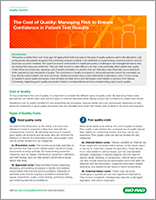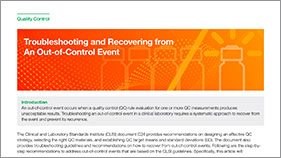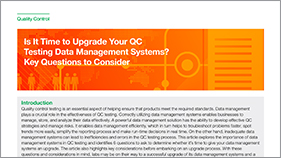
- Share on:
- Bio-rad Twitter
- Bio-rad Facebook
- Bio-rad LinkedIn
Understanding the Cost of Quality and maintaining good QC processes
“Prevention is better than cure” is an age-old saying that holds true even in the area of quality systems used in the laboratory. Lab professionals everywhere recognize that preventing adverse incidents is far preferable to implementing corrective actions once an issue has occurred. However, the current economic environment in healthcare poses a challenge to lab management teams who are finding their resources stretched. They are often forced to make difficult cuts that could potentially affect patient test quality.Under these circumstances, applying cost-of-quality principles is a solution that can help labs make financially sound decisions while maintaining high standards of quality. The importance of quality processes in clinical laboratories cannot be overstated, as they directly impact patient care and outcomes. Quality processes have a clear relationship to laboratory costs. If more money is invested in good quality processes, there will likely be fewer errors and decreased costs related to recovery from failures. Conversely, neglecting good quality processes is likely to increase failures and the corresponding costs of poor quality.

Download the Article
Share a little information with us to access the entire article now.
Thank you for your interest in ! Access the article here.
View ArticleRecommended Features
-
Image

Troubleshooting and Recovering from An Out-of-Control Event
Important steps to take when troubleshooting QC lab results and mitigating out-of-control QC events.
-

5 Ways to Save Money by Avoiding Costs due to Poor Quality
Learn how to best identify, track, and manage quality costs in your laboratory.
-
Image

Is It Time to Upgrade Your QC Testing Data Management Systems. Key Questions to Consider
Questions to consider when determining if it's time to upgrade your quality control system.


